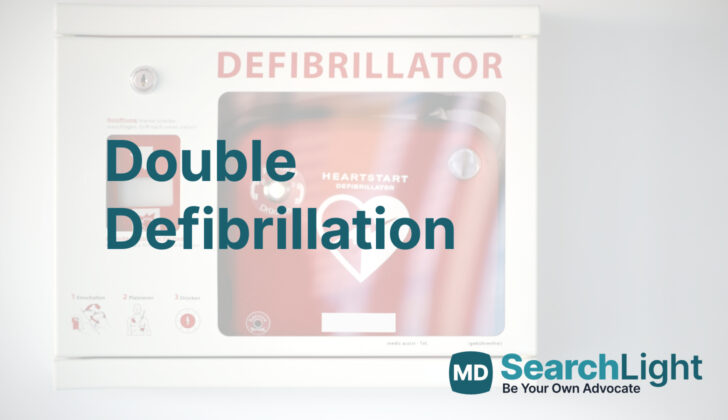Overview of Double Defibrillation
Double external defibrillation (DED) refers to using two defibrillator devices at the same time to treat one patient who is having a specific type of severe irregular heart rhythm, also known as refractory ventricular fibrillation (RVF) during a heart attack. Refractory ventricular fibrillation is when the heart beats in a rapid and erratic way and does not return to a normal rhythm even after three or more attempts to correct it with a defibrillator. It is a very serious condition, affecting between 0.5 and 0.6 in every 100,000 people and occurring in up to 25% of heart attack cases. The survival rate for patients with RVF during a heart attack is extremely low, up to 97% do not survive.
In November 2020, the American Heart Association updated its guidelines and now does not recommend using double sequential defibrillation for this severe irregular heart rhythm. This technique is usually only used when standard treatment with a single defibrillator doesn’t work.
Several theories have been suggested as to why DED might be effective:
The first, the ‘Power Theory’, suggests that using a higher energy level can increase the success of the defibrillation. This approach requires the two defibrillators to be used either at the exact same time or very closely together. This has led to the technique being commonly referred to as “double simultaneous defibrillation”.
The second theory, known as the ‘Setting Up Theory’, proposes that the initial defibrillation lowers the amount of energy needed to correct the heart rhythm, potentially improving the chance of success for the second round of defibrillation. With this theory, the two defibrillations should be done close together, but not at exactly the same time. This has led to the technique sometimes being called “double sequential defibrillation”.
The third theory, know as ‘Multiple Vector Theory’, is based on the idea that using multiple defibrillator pads can create more pathways for the electrical current to reach the heart muscle. This is thought to potentially improve the chances of the heart returning to a normal rhythm.
Why do People Need Double Defibrillation
Early use of a defibrillator, a device that shocks the heart back to a normal rhythm, is recommended for a condition called refractory ventricular fibrillation (RVF). RVF is a serious heart rhythm problem where the lower chambers of the heart (the ventricles) quiver instead of pumping blood normally. This condition doesn’t respond to three or more attempts to correct it with a defibrillator.
When a Person Should Avoid Double Defibrillation
There are no specific reasons why someone couldn’t receive a treatment called double defibrillation. It doesn’t matter if a person has a pacemaker or an internal heart defibrillator implanted. These devices won’t affect whether or not someone can receive double defibrillation.
Equipment used for Double Defibrillation
* Two defibrillators with a biphasic feature
* Two pairs of defibrillator pads
Who is needed to perform Double Defibrillation?
If we’re going by the ‘power theory’, you need one healthcare provider who’s skilled in Advanced Cardiac Life Support (ACLS) – a type of emergency medical procedure – to operate both life-saving defibrillator devices. However, if we’re sticking to the ‘setting up theory’, then you’ll need two healthcare providers with ACLS knowledge. Each of them will handle one of the two defibrillator devices. This ensures that the operation and use of these devices are done correctly, safely, and effectively.
Preparing for Double Defibrillation
If a patient’s heart is in a state called ventricular fibrillation, where the heart beats with rapid, erratic electrical impulses, they might need more than one shock from a defibrillator. A defibrillator is a device that delivers an electric shock to the heart to restore its normal rhythm. If a second shock is required, a second defibrillator should be prepared and positioned near the first one. This allows a single person to operate both machines if needed. For patients who already received two or more shocks before reaching the hospital, the defibrillator patches should be placed when the patient is moved from the ambulance to the hospital bed.
While many defibrillators still use manual paddles for delivering the shock, most companies that make these machines suggest using stick-on pads instead. These hands-free pads ensure that the electric shock is delivered properly and prevents operator error. Before putting them on the patient, always check that you have the correct size pads for the second defibrillator.
Placement of Defibrillator Pads:
The initial set of defibrillator pads should stay where they were initially placed: one along the upper right edge of the sternum (the bone in the center of your chest), and the other placed at the location of the cardiac apex (the lower pointed end of the heart). It is NOT SAFE to let the two sets of defibrillator pads touch each other as it could damage either or both of the devices. Manufacturers will not cover any damage caused by this mistake.
The placement of the second set of defibrillator pads comes with two options:
1. Position the first pad near, but not touching, the pad at the right edge of the sternum, and the second one next to, but not touching, the pad at the cardiac apex.
2. The pads could also be arranged in an anteroposterior fashion–one pad on the front of the patient and the other on the back. This option is often the best choice because it’s easier to do when transferring a patient from an ambulance stretcher to a hospital bed, and it lowers the risk of the pads touching each other and damaging the defibrillator devices.
How is Double Defibrillation performed
If you’re using two defibrillators at the same time following the “power theory,” it’s suggested that one healthcare provider should handle both devices. This is to make sure the shock from the defibrillators is given as simultaneously as possible.
If you’re using the “setting up theory” where defibrillators are used one after the other, it’s recommended that two healthcare providers each handle one defibrillator. This ensures there’s a deliberate gap between the two shocks given to the patient. However, if there’s only one healthcare provider present who is trained in Advanced Cardiac Life Support (ACLS), they can press the “shock” button on both defibrillators with one hand. This ensures that there is a deliberate gap between the shocks.
According to current guidelines, it’s crucial to keep interruptions to chest compressions to a minimum when using a single defibrillator. While the defibrillators are charging up to their first energy level of 200 Joules, chest compressions should continue. Once both machines are fully charged, and everyone has been checked to ensure they aren’t touching the patient or anything connected to the patient, the shock is given using one of the two methods mentioned above. Immediately after the shock, chest compressions should continue. The patient’s pulse is checked after the next 2-minute round of compressions.
Possible Complications of Double Defibrillation
Many research studies have demonstrated that it’s safe for a patient to receive up to 720 Joules of energy. Importantly, this energy level doesn’t need to be adjusted based on the patient’s weight.
As highlighted before, there is the potential for harm to one or both defibrillator devices (machines that deliver electric shocks to the heart) if the pads that deliver the shock are touching each other when the shocks are given. It’s important to understand that if a defibrillator is damaged because of this, it is usually not included in the manufacturer’s warranty or guarantee.
What Else Should I Know About Double Defibrillation?
There have been several cases reported which highlight the effectiveness of using a second defibrillator (a device used to restart the heart) to stop a type of irregular heart rhythm known as Refractory Ventricular Fibrillation (RVF). RVF is a severe condition where the heart quivers instead of effectively pumping blood.
A thorough review of these reports showed that in 77% of 39 cases, using two defibrillators (a strategy called Dual External Defibrillation, or DED) successfully stopped the RVF. What’s more, 11 of these patients were able to leave the hospital with their brains working well, as shown by their good scores on a measure of brain function called the Cerebral Performance Category score.
Currently, though, there’s no evidence to show that one specific method of using two defibrillators is more successful than others in stopping RVF. On the other hand, more studies are needed for a better understanding of DED. Since using a second defibrillator can provide a benefit, it is a point to consider when treating a patient with RVF.












